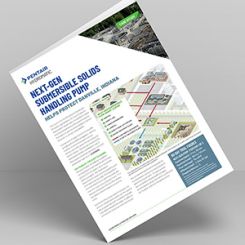Where commercial enterprises, residential properties and agriculture occupy low-lying land in river deltas, the possibility of flooding demands consideration. Rising river and sea levels coupled with seasonal heavy rain and snow is a powerful and potentially disastrous combination. The appropriate authorities must invest in both drainage and pumping systems to protect assets. The city of Richmond, Canada, is an example of such a location. City authorities have invested in a flood protection infrastructure that has prevented significant flooding in the community for more than 60 years. The infrastructure is a combination of dikes constructed around the 51-square-mile island on which the city is located, a network of streams and drainage channels, and 41 strategically positioned pumping stations.
 Image 1. The award-winning Cambie Road pumping station (Images courtesy of KSB)
Image 1. The award-winning Cambie Road pumping station (Images courtesy of KSB) Image 2. This pump serves in many flood control applications.
Image 2. This pump serves in many flood control applications.Pump Station Design
Water pumping stations are not usually aesthetically pleasing and can be noisy, which is why they are typically located away from residential areas. For the pumping stations to have the minimum visual impact on the environment, Richmond has given a great deal of thought to their design and construction. This approach was rewarded when the Cambie Pumping station (see Image 1), located in a light industrial area close to a residential development on the Fraser River, won a design award. The station has a vegetation-covered roof to blend in with the environment and is built into the dike giving walkers a rest facility along the river. The design also includes a sculpture by the pump house designed to resemble a droplet of water. The No. 4 Road pumping station is in a former industrial area that is going through a residential transition (see Image 3). Converted from a long shaft pump station, the design incorporated aspects of the old station together with the crane lifting frame that now acts as a viewing platform. The walls of the pump house depict the history of the lumber business along the Fraser River, and the standby power generation plant is visible though clear glass walls. By deliberately making the pumping station visually attractive, practical and a community amenity, vandalism is deterred. Image 3. Romeo Bicego and Derek Hunter at No. 4 Road pumping station.
Image 3. Romeo Bicego and Derek Hunter at No. 4 Road pumping station. Image 4. Spillways are designed to minimize the environmental impacts of outflow from pump stations.
Image 4. Spillways are designed to minimize the environmental impacts of outflow from pump stations.Planning for the Future
The challenge that faces the city of Richmond is unusual, with occupancy and use being split between residential/commercial and agricultural activities. The city is part of Canada's largest cranberry growing area, and the fields have to be flooded at harvest time (see Image 5). However, water levels in the drainage channels must be kept low enough that other parts of the island do not flood. It is a delicate balancing act that combines irrigation, drainage and flood control. Image 5. Cranberries are the single largest crop grown in the city of Richmond and the fields are flooded during the harvesting period.
Image 5. Cranberries are the single largest crop grown in the city of Richmond and the fields are flooded during the harvesting period.
